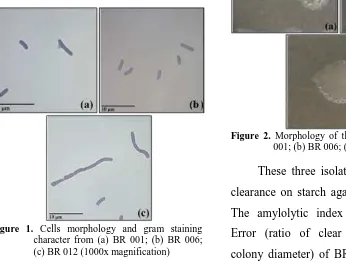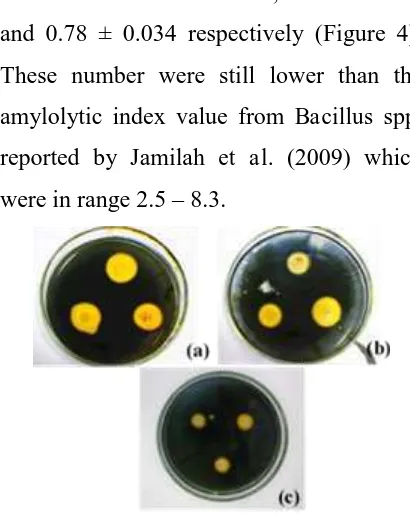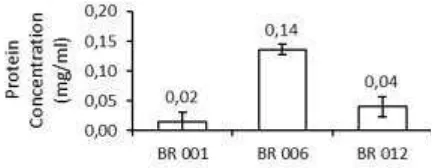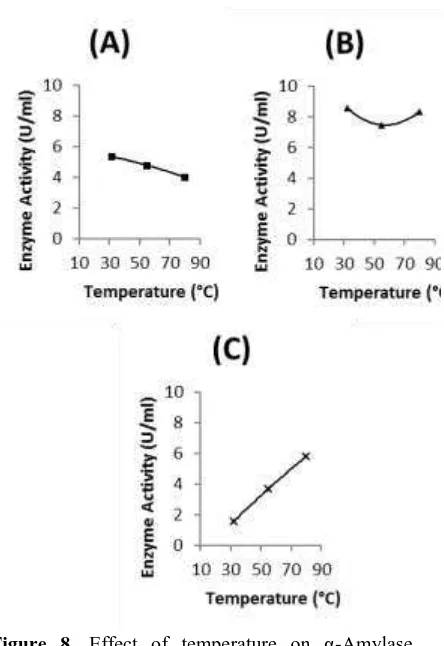Characterization of
α
-Amylase Activity from Thermophilic Bacteria
Isolated from Bora Hot spring, Central Sulawesi
Karakterisasi Aktivitas α
-Amilase dari Isolat Bakteri Termofilik dari Mata
Air Panas Bora, Sulawesi Tengah
Faris Muhammad Gazali*), Meryany Ananda and I Nengah Suwastika
Department of Biology, Faculty of Sciences, Tadulako University, Jl. Soekarno-Hatta Km 9, Palu 94118 Indonesia
ABSTRACT
α-Amilase (EC 3.2.1.1) is one of the most important enzyme in biotechnology. This enzyme had been implemented in various sector of industry, such as detergen, textile, paper,
bread, alcohol, and starch. Thermostability of α-Amilase is one of main property which is
needed in starch degrading industry. A Thermostable α-Amilase could be obtained from thermophilic bacteria in which naturally could be isolated from hot spring. Bora hot spring is one of the most potential habitat in isolating thermophilic bacteria as it possessed a highly water temperature up to 90,1°C. The present study was concerned to the characterization of
α-Amilase activity from indigenous thermophilic bacteria isolated from Bora hot spring, Central Sulawesi. There were 13 (out of 18) thermophilic bacterial isolates from Bora hot
spring which could produce α-Amilase in which succesfully isolated from sediment samples. Among those 13 bacteria, 3 selected isolates were described throughout this paper, they were BR 001, BR 006, and BR 012. These 3 isolates had a character of: amylolytic index value in range 0.78 – 1.44; α-Amylase activity in range 3.67 U/ml – 7.6 U/ml; protein concentration in range 0.02 mg/ml – 0.14 mg/ml; α-Amylase crude enzyme specific activity in range 54.83 U/mg – 308.45 U/mg; α-Amylase which active in temperature range 32°C – 80°C and had an optimum temperature in range <32°C and >80°C; and α-Amylase which active in pH range 5
– 7 and had an optimum pH in range 6.5 – 7. The presence of enzyme activity at high
temperature from α-Amilase produced by indigenous thermophilic bacteria from Bora hot spring indicated a suitable potential in the application of local enzyme to industrial sector in the future, particulary to the starch processing industry.
ABSTRAK
α-Amilase (EC 3.2.1.1) merupakan salah satu jenis enzim yang sangat penting dalam bioteknologi. Enzim ini sering diaplikasikan pada berbagai sektor industri, seperti industri deterjen, tekstil, kertas, roti, alkohol, dan pati. Termostabilitas dari α-Amilase merupakan
sifat utama dari enzim yang dibutuhkan pada industri pemerosesan pati. α-Amilase dengan sifat termostabil dapat diperoleh dari bakteri termofilik yang secara alami dapat diisolasi dari mata air panas. Mata air panas Bora merupakan salah satu habitat yang paling berpotensi dalam mengisolasi bakteri termofilik karena memiliki suhu air yang sangat tinggi hingga
mencapai 90,1°C. Penelitian ini bertujuan untuk mengetahui karakter aktivitas α-Amilase dari bakteri termofilik lokal isolat mata air Bora, Sulawesi Tengah. Terdapat 13 (dari 18 isolat)
bakteri termofilik isolat mata air panas Bora yang mampu menghasilkan α-Amilase yang berhasil diisolasi dari sampel sedimen. Dari 13 isolat tersebut, 3 isolat terpilih dideskripsikan pada tulisan ini, yakni BR 001, BR 006, and BR 012. Ketiga isolat tersebut memiliki karakter: nilai indeks amilolitik berkisar 0,78 – 1,44; aktivitas α-Amilase berkisar berkisar 3,67 U/ml – 7,6 U/ml; konsentrasi protein berkisar 0,02 mg/ml – 0,14 mg/ml; aktivitas
spesifik enzim kasar α-Amilase berkisar 54,83 U/mg – 308,45 U/mg; α-Amilase yang aktif pada kisaran suhu 32°C – 80°C; dan α-Amilase yang aktif pada kisaran pH 5 – 7 dan memiliki pH optimum pada kisaran 6,5 – 7. Adanya aktivitas enzim pada suhu yang tinggi
dari α-Amilase yang diproduksi oleh isolat bakteri termofilik lokal dari mata air panas Bora menunjukkan adanya potensi dalam aplikasi enzim lokal pada sektor industri di masa depan, khususnya pada industri pemerosesan pati.
Kata kunci: Aktivitas Enzim, α-Amilase, Bakteri Termofilik, Mata Air Panas
INTRODUCTION
α-Amylase (E.C. 3.2.2.1.) is a hydrolase enzyme belongs to family 13
(GH-13) of glycoside hydrolase, which
catalyzes the hydrolysis of internal α -1,4-glycosidic bonds in starch to yield products
like glucose, maltose, and maltotriose units
(Sivaramakrishnan et al., 2006; de Souza
and e Magalhães, 2010). These enzymes
can be produced by plants, animals, and
microbes (Sundarram and Murthy, 2014).
The most widely used α-Amylase in
industrial application is α-Amylase coming from microbes (Reddy et al., 2003). It
possesses some advantages such as cost
effectiveness, large productivity,
consistency, less time and space needs for
production, and also easy to modify and
optimize the process of production (de
Souza and e Magalhães, 2010).
α-Amylase plays an important role in biotechnology field, particularly for
industrial needs (Pandey et al., 2000). It
constitutes a class of industrial enzymes
having approximately 25-30% of the world
enzyme market (Deb et al., 2013). Various
industry has been known to use α-Amylase in their industrial process ranging from
to paper industry (de Souza and e
Magalhães, 2010).
The most widespread applications of
α-Amylase are in the starch industry (de Souza and e Magalhães, 2010). Starch
industry needs a thermostable α-Amylase in the starch processing as the process of
gelatinization, liquefaction, and
saccharification are performed in high
temperature (Mehta and Satyanarayana,
2016). Thermostable α-Amylase could be isolated from mesophilic microbes,
thermophilic microbes as well as
hyperthermophilic microbes. These
microbes possess unique properties of α -Amylase, including specificity,
themostability, and pH response which are
a critical properties for industrial use
(Vieille et al., 2001). Screening of
microbes with high α-Amylase activity, high thermostability, proper optimum
condition of pH and temperature could
therefore facilitate the discovery of newly
suitable α-Amylase for industrial application (Asgher et al., 2007).
Hot spring is one of the habitat of
thermophilic bacteria which offers great
potential on isolation of thermostable α -Amylase (Madigan and Marrs, 1997; Mehta
and Satyanarayana, 2016). Bora hot springs
is one of the hot spring located at Central
Sulawesi with water temperature up to
90,1ºC (Idral and Mansoer, 2015).
Therefore, it is mostly possible to isolate
the bacteria which could produce highly
thermostable α-Amylase from that hot spring.
Little is known about the character of
the α-Amylase produced by indigenous thermophilic bacteria in Indonesia,
particularly in Central Sulawesi. The
presence of enzyme activity at high
temperature from α-Amilase produced by indigenous thermophilic bacteria from Bora
hot spring indicated a suitable potential in
the application of local enzyme to industrial
sector in the future, particulary to the starch
processing industry.
MATERIAL AND METHODS
1. Sample collection and isolation of
thermophilic bacteria
Sediment samples were collected
from Bora hot spring, Central Sulawesi,
Indonesia. Sediment samples were
homogenized by continuously mixing 10 g
of sediment samples with 90 ml of 0.9%
NaCl solution in 150 rpm of orbital shaker
at 55°C for 30 minutes. A serial dilution
technique was performed up to 10-9 to
dilute the samples. Luria Bertani Agar was
used as an isolation and cultivation media
of thermophilic bacteria isolates which
incubated at 55°C for 24 hours to obtain the
2. Screening of amylase-producing
thermophilic bacteria
Starch agar plate was used as a media
for screening of amylase-producing
thermophilic bacteria. The pure isolates
colonies were inoculated and streaked on
0.002% starch agar plates and incubated at
55°C for 24 hours. After incubation, the
plates were flooded by Gram’s Iodine (2% I2 and 0.2% KI) to produce starch-iodine
complex which is visualized by deep blue
color. No color would be appeared at
starch-free zone which is known to be the
zone of clearance. The appearance of clear
zone at starch agar plate was used as the
main indicator of the activity of starch
degrading enzyme produced by the
bacterial isolates. The bacterial isolates
which produced clear zone at starch agar
plate were further characterized.
3. Amylolytic index value determination
Amylase producing bacteria colonies
were sub-cultured at Luria Bertani Broth
media and incubated at 55°C for 24 hours.
After incubation, 10 µl of bacterial culture
were inoculated to filter paper at 0.002%
starch agar plate. The agar plates were
incubated at 55°C for 48 hours. After
incubation, the plates were flooded by
Gram’s Iodine (2% I2 and 0.2% KI) and the amylolytic index value of each isolates was
determined based on the ratio of clear zone
diameter (cm) formed by the bacterial
colony and its diameter of colony (cm)
(Jamilah et al., 2009). Bacterial isolates
with high amylolytic index value were
further characterized.
4. Characterization of selected
amylase-producing thermophilic bacteria
Several characterization consist of
cells morphology, gram staining character,
colony morphology, and biochemical assay
including various sugar fermentation
(glucose, lactose, and sucrose) from the
selected amylase-producing thermophilic
bacteria were studied in this works.
5. Crude enzyme production
Three isolates were initially
subcultured at basal medium containing 1%
starch according to Ashger et al. (2007) and
incubated at 55°C for 48 hours without
shaking. After incubation, 5 ml of the
cultures were transferred to 45 ml sterile
basal medium and incubated at 55°C for 48
hours on 130 rpm of orbital shaker. The
crude enzyme of each isolates was obtained
after centrifugation process of 48 hours
cultures. The cultures were centrifuged at
8,000 rpm on 4°C to sediment the cell.
Cells free supernatant was used as the
crude enzyme for enzyme assay. The
enzyme assays were performed
immediately after centrifugation process to
6. Soluble Protein Estimation
Extracellular soluble protein in
culture filtrate was estimated by the
ciocalteau reagent was added and shaken to
mix well and incubated for about 30 min to
60 min at at 55°C in the dark condition.
Optical density of the reaction mixture was
measured at 750 nm, against a blank
prepared with 50 µl sterile basal medium
with 1% starch (Ashger et al., 2007). A
standard curve was constructed with each
experiment using bovine serum albumin as
a known protein. The amount of the soluble
protein was calculated from the standard
curve of as mg protein per ml of test
samples.
7. Enzyme activity assay
α-Amylase activity was determined by measuring the increase of reducing
sugar as maltose formed by the hydrolysis
of starch. The quantity of the releasing
reducing sugar was determined by
3,5-dinitrosalicylic acid method according to
Bernfeld (1955). A 1.0% (w/v) solution of
starch in 50 mM Phosphate Buffer (pH 7.0)
was used as a substrate. The reaction
mixture (100 µl), containing 50 µl crude
enzyme and 50 µl substrate was incubated
at 55°C for 15 minutes. After incubation,
50 µl of 3,5-dinitrosalicylic acid was added
to stop reaction. This reaction mixture was
boiled for 15 minutes and diluted 4 times
with dH2O. The blank was made by adding
3,5-dinitrosalicylic acid before the crude
enzyme. Also, the control was made by
adding 3,5-dinitrosalicylic acid before the
substrate. The absorbance was measured at
540 nm, where one unit of α-Amylase enzyme corresponded to the formation of 1
µmol reducing sugar as maltose per minute
in 50 mM Phosphate Buffer (pH 7.0) with
1% soluble starch at 55°C. At last, the α -Amylase specific activity (U/mg) could be
determined from the ratio of α-Amylase activity with its protein concentration.
8. Effect of temperature and pH on α-Amylase
activity
Effect of temperature on α-Amylase activity was determined by performing
enzyme assay at a various temperature
ranging on 32°C - 80°C. Effect of pH on α -Amylase activity was determined by
performing enzyme assay at various pH
ranging on 5 - 8.6 using 50 mM citrate
buffer, 50 mM phosphate buffer, and 50
mM tris-HCl buffer. The optimum
condition (of both temperature and pH) was
determined by polynomial regression
RESULT AND DISCUSSION
Eighteen bacterial colonies were
successfully isolated from sediment
samples, collected from Bora hot spring,
Central Sulawesi, Indonesia. Among these
18 isolates, 13 isolates showed amylolytic
activity at 0.002% starch agar plates. Three
isolates consist of BR 001, BR 006, and BR
012 were described throughout this paper.
All these three isolates were
rod-shaped bacteria or called bacil with 2.5 – 3.2 µm long and 0.9 – 1.1 µm wide, and stained as purple which were classified as a
Gram positive bacteria (Figure 1). Several
rod-shaped Gram positive bacteria,
particularly from Bacillus spp. were
reported as good α-Amylase producers
which had high α-Amylase production with
high enzyme activity and possess high
thermostability (Reddy et al., 2003).
Figure 1. Cells morphology and gram staining character from (a) BR 001; (b) BR 006; (c) BR 012 (1000x magnification)
The character of colony morphology
was determined based on size,
pigmentation, shape, margin, and opacity.
BR 001 showed a white colony which were
irregular in shape and had a lobate margin
(Figure 2a). BR 006 showed a small milky
white colony which were filamentous in
shape and margin (Figure 2b). BR 012
showed a small white colony which were
irregular in shape and had an undulate
margin (Figure 2c). All these three isolates
colony showed opaque character in colony
opacity. On the other hand, BR 001 and BR
006 showed similar biochemical character
with no fermentation process were
observed in any sugar test, whereas BR 012
showed a positive test in glucose and
sucrose test, but not in lactose test.
Figure 2. Morphology of the colony from (a) BR 001; (b) BR 006; (c) BR 012
These three isolates showed zone of
clearance on starch agar plates (Figure 3).
The amylolytic index value ± Standard
Error (ratio of clear zone diameter to
BR 012 were 1.44 ± 0.099, 0.87 ± 0.062,
and 0.78 ± 0.034 respectively (Figure 4).
These number were still lower than the
amylolytic index value from Bacillus spp.
reported by Jamilah et al. (2009) which
were in range 2.5 – 8.3.
Figure 3. Zone of clearance on starch agar plates from (a) BR 001; (b) BR 006; (c) BR 012
Figure 4. Amylolytic index value
The enzyme activity was further
characterized quantitatively using
3,5-dinitrosalicylic acid method. α-Amylase activity ± Standard Error from BR 001, BR
006, and BR 015 were 4.79 U/ml ± 0.559,
7.46 U/ml ± 0.113, and 3.67 U/ml ± 0.113,
respectively (Figure 5). These number
showed higher value of α-Amylase activity compared with α-Amylase activity from Bacillus spp. reported by Jamilah et al.
(2009) which only had it up to 2.5 U/ml.
However, these number were still lower
than the enzyme activity from several
bacteria which had already implemented in
industrial sector, such as Bacillus subtilis
JS with α-Amylase activity up to 44.84 U/ml (Asgher et al., 2007). This data also
showed that α-Amylase activity from these three isolates didn’t correspond with the value of amylolytic index which would be
caused by the difference of medium
composition, including the presence of
yeast extract, persentage of the starch, and
the state of medium to be used (Asgher et
al., 2007; Florencio et al., 2012). The same
works were carried out by Goyari et al.
(2014) which described the relative enzyme
index on plate agar was not correspond
with the enzyme activity.
Figure 5. α-Amylase activity
Enzyme specific activity could be
determined by knowing the concentration
of the protein in the supernatant. Based on
Lowry method as previously described, the
protein concentration ± Standard Error of
mg/ml ± 0.016, 0.14 mg/ml ± 0.009, and
0.04 mg/ml ± 0.017 respectively (Figure 6).
According to those protein concentration,
the α-Amylase specific activity from BR 001, BR 006, and BR 012 were 308.45
U/mg, 54.83 U/mg, and 92.19 U/mg
(Figure 7). These number showed higher
value of α-Amylase specific activity compared with the α-Amylase specific
activity from Alicyclobacillus
acidocaldarius reported by Kumar et al.
(2010) which only had it up to 398 U/mg,
but significantly showed a lower value
when it compared with the purified enzyme
from Alicyclobacillus acidocaldarius which
had α-Amylase specific activity up to 3239 U/mg. It suggests that the increasing
number of α-Amylase specific activity was corresponding with the purity level of the
enzyme.
Figure 6. Protein concentration of the crude enzyme
Figure 7. Spesific α-Amylase activity
The effect of temperature on α -Amylase activity was shown in Figure 8.
The α-Amylase activity of BR 001 was found to decrease at temperature ranging on
32ºC to 90ºC and it suggested that the
optimum temperature was below 32ºC.
Meanwhile, the α-Amylase activity of BR 006 was found to decrease at temperature
ranging on 32ºC to 55ºC and start to
increase at temperature ranging on 55ºC to
80ºC, and it suggested that the optimum
temperature was below 32ºC or above
80ºC. On the other hand, the α-Amylase activity of BR 012 was found to increase at
temperature ranging on 32ºC to 90ºC and it
suggested that the optimum temperature
was above 80ºC. It was explained that the
α-Amylase activity from all these three isolates was found to have widely range of
active temperature as well as higher
optimum temperature, particularly for
isolates BR 012. In addition, the abbility of
α-Amylase produced by all these three isolates to be able to active at high
temperature, as well as the optimum
temperature exceeding 80ºC from BR 012
and mostly possible BR 006 confirm the
suitable character needed by most of
industrial sector, specially starch
processing industry as had been mentioned
Figure 8. Effect of temperature on α-Amylase activity from (a) BR 001; (b) BR 006; (c) BR 012
The effect of pH on α-Amylase activity is shown in Figure 9. The effect of
pH on α-Amylase activity of BR 001 was found to be similar with BR 012. No
enzyme activity to a very slight enzyme
activity was shown at pH 5 in α-Amylase from both isolates. The enzyme activity
from both isolates started to significantly
increase until it reached pH around 7.0 and
begin to decrease afterwards. The optimum
pH of both BR 001 and BR 012 isolates
was pH around 7. Meanwhile, α-Amylase activity from BR 006 showed good activity
at pH 5 and continued to increase until it
reached pH around 6.5, then it started to
significantly decrease until only a very
slight enzyme activity was observed at pH
8.6. Itsuggested that the optimum pH of α -Amylase from BR 006 was pH around 6.5
or slightly acid. The same works were
performed by Bajpai et al. (2009) and
Kumar et al. (2010) which had
characterized optimum pH of α-Amylase at slightly acid to netral produced by
thermophiles.
Figure 9. Effect of pH on α-Amylase activity from (a) BR 001; (b) BR 006; (c) BR 012
α-Amylase activity from all these three isolates which could active at high
temperature as well as had an optimum
temperature at a very high temperature,
showed good potential for the application
in industrial sector. However, it was still far
from the real implementation regarding the
compare with the Bacillus sp. α-Amylase activity (up to 57 U/ml) (Cordeiro et al.,
2002) which commonly had already been
implemented in industrial sector.
Furthermore, further detail characterization
such as in enzyme purification,
determination of enzyme stability against
temperature and pH, effect of enzyme
co-factor, and effect of inhibitor are required
to know the exact properties of the enzyme.
The crude of α-Amylase from indigenous thermophilic bacteria isolates
could active at high temperature where the
other enzyme would denature. However,
these characteristics were not enough to use
the enzyme in industrial application
because of the low of enzyme activity.
Furthermore, further characterization
should be performed in order to know the
exact properties of the enzyme
ACKNOWLEDGEMENTS
The authors wish to thank Biology
Department, Faculty of Sciences, Tadulako
University for facilitating this work. We
would like to thank Mr. Syamsuddin and
staffs of Bora hot spring for the assitance
during field sampling. Our thank also to
Sami Bukang, Magfirahtul Jannah, Orryani
Lambui, and all laboratory staff at Biology
Department for their help in laboratory moderately thermophilic Bacillus subtilis strain for starch
from an extremely halophilic archaeon, Haloferax sp. HA10, Food Technol Biotechnol, Vol. 53 : 11–17. and properties of alpha-amylase from thermophilic Bacillus sp., 2013, Production and partial characterization of extracellular amylase enzyme from Bacillus amyloliquefaciens P-001, Springerplus, Vol. 2 : 154.
Goyal, N., Gupta, J. K., and Soni, S. K., 2005, A novel raw starch digesting
thermostable α-amylase from
starch, Enzyme Microb. Technol., Vol. 37 : 723–734.
Goyari, S., Devi, S. S., Kalita, M. C., and Talukdar, N. C., 2014, Population, diversity and characteristics of cellulolytic microorganisms from the Indo-Burma Biodiversity hotspot, Springerplus, Vol. 3 : 700.
Idral, A. and Mansoer, W. R., 2015, Integrated geophysical studies of palu-koro depression zone, indonesia: implications for geothermal resources in bora
central sulawesi, World
Geotherm. Congr., 1–5.
Jamilah, I., Meryandini, A., Rusmana, I., Suwanto, A., and Rachmania, M. N., 2009, Activity of proteolytic and amylolytic enzymes from Bacillus spp. isolated from shrimp ponds, Microbiol. Indones., Vol. 3 : 67–71.
Kumar, G. S., Chandra, M. S., Mallaiah, K. V., Sreenivasulu, P., and Choi, Y. L., 2010, Purification and characterization of highly thermostable α-amylase from thermophilic Alicyclobacillus
Bacterial and archaeal α
-amylases: Diversity and amelioration of the desirable characteristics for industrial
applications, Front. Microbiol., Vol. 7 : 1–21.
Pandey, A., Nigam, P., Soccol, C. R., Soccol, V. T., Singh, D., and Mohan, R., 2000, Advances in microbial amylases, Biotechnol. Appl. Biochem., Vol. 31 : 135–
Sivaramakrishnan, S., Gangadharan, D., Madhavan, K., Soccol, C. R., Pandey, A., Nampoothiri, K. M., Soccol, C. R., and Pandey, A., 2006, alpha-amylases from microbial sources - An overview Environ. Microbiol., Vol. 2 : 166– 75.
Vieille, C., Zeikus, G. J., and Vieille, C.,
2001, Hyperthermophilic



